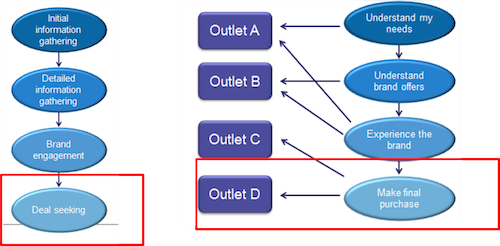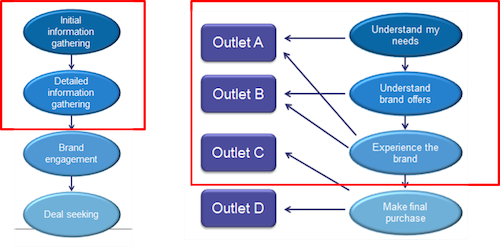Brands are often presented with a variety of sales outlets to choose from – shopping malls, standalone stores, and discount stores, for instance. In some of our past work with electronics companies, we’ve learnt that the decision of which channel is best depends on two main factors – the type of target shoppers, and the stage of the purchase journey in which the shopper is in at the moment they are at the store. Understanding shoppers in this way is key to retail success
In my recent visit to the Commart Fair – one of the biggest computer and computer accessories fair in Bangkok – I found this exact concept on channel strategy at play.
In Bangkok, a major electronics fair is organized pretty much every month. These popular events normally draw a multitude of dealers, vendors, retailers and, of course, event-goers in numbers large enough to jam pack the streets around the fair venues with cars for hours. With the commuting effort, there is clearly a very high desire for visitors to go to these events!
These fairs are typically characterized by chaos and clamor. As I set foot into the Commart, I saw big and unorganized displays of the latest laptops; handwritten posters and signs hanging from booths screaming price cuts; minimally-dressed female product consultants boasting their products’ features; and a very big, loud crowd of event-goers trying to get a glimpse of the latest gadgets.
Are Brand Image and Positioning Not Important
For the marketer who is more accustomed to neatly laid-out, brightly-lit shopping malls, these fairs might come as a shock. High-end laptops and printers are placed on the floor with scribbly handwritten slashed price tags attached to them, while headphones, hard disks, and other accessories are disorderly stacked on top of each other in giant boxes… What has happened to maintaining a strong brand image and positioning?
To understand what’s at play at these events, it is essential to consider 1) the channel role and 2) the shopper behavior attempted to be influenced.
The Deal-Seeker Shopper
Shoppers visiting these fairs are generally planned shoppers who know what they are looking for. Many may have already researched online or via showrooming in more recognized retail channels. They have been waiting anxiously for the fair to make the purchase, knowing that they can get deals and discounts that are unavailable elsewhere. At this stage of the purchase journey, what is needed to close the deal are the price cuts, the freebies, and the extra deals.
For these shoppers, the store environment and the brand image are potentially less relevant.
In the diagram below, fairs like these are comparable to Outlet D – attracting and serving shoppers who are about to make the final purchase.

Information Gatherer Shopper
The other group of people found roaming these fairs are the information gatherers – shoppers in the early stages of the journey, having some idea of what they want but need more information. They are learning about the products – they want to check out the various models, brands, and play around with the gadgets. With the abundance of products, brands, and product consultants, these fairs are the place to be.
Winning Channel Strategy – Understanding How Shoppers Interact With Channels
Different sales outlets may play different roles, and winning channel strategy takes an understanding of how shoppers interact with channels. Here are a few things marketers should not forget:
- Understand what roles channels play for your shoppers. Are shoppers there to look for more information about your products, to compare different brands, or to buy? And even though deal seekers may have already made up their minds on a brand, but what if they could be swayed?
- As the Commart Fair example illustrates, some channels play multiple roles. It is important to determine which channels play which roles to which shopper and ensure that channels are set up to serve the priority roles. It is important also to determine which segment is most important in this channel. Deal seekers buy today, but are manufacturers making too little effort to sway the information gatherers – who might be profitable by buying without discount later on?
- What is the risk of the long term brand health? Branding must be consistent – being in a discount sales setting does not give brands an excuse to forgo essential branding elements. Remember that anywhere and everywhere is a potential brand touch point that could affect sales, brand image, and customer relationships.
If you would like to learn more about channel strategy or similar cases to this, don’t hesitate to contact us!


